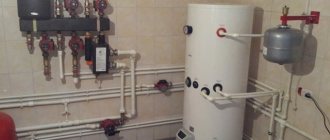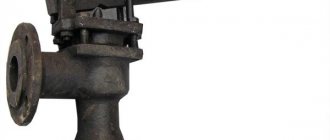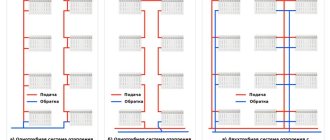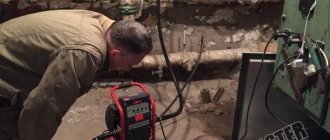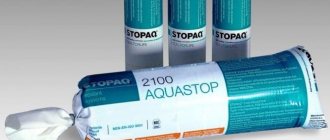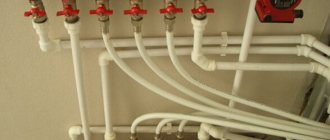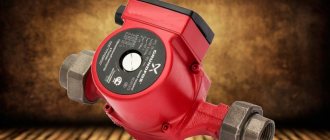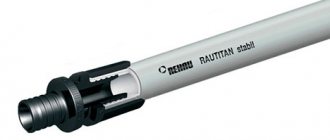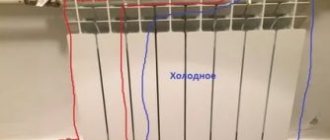Hydraulic testing of pipelines
Preparatory work
Before carrying out hydraulic tests of heating system pipelines, it is necessary to carry out a set of preparatory work.
- The structure is divided into conventional divisions.
- An external visual inspection is carried out.
- Technical documentation is checked.
- Drain valves, plugs, and air valves are attached to the divisions.
- Install a temporary pipeline line from the filling and pressing devices.
- The section being tested is disconnected from the remaining pipe divisions using plugs with shanks, and is disconnected from the apparatus and equipment. Important: it is prohibited to use the complete shut-off valves of the wire itself for these purposes.
- To test pipelines for strength and density, they are connected to hydraulics (compressors, pumping stations, presses or air networks), creating the pressure required for testing, at a distance of 2 valves.
Hydraulic tests are carried out only under the supervision of the manufacturer or under the guidance of a foreman, in strict accordance with the requirements of technical documentation, instructions and design papers. Gosgortekhnadzor regulations and safety regulations must be observed.
Please note: equipment and test devices (pressure gauges, etc.) undergo mandatory preliminary testing and sealing. The minimum accuracy class of pressure gauges is 1.5 (according to GOST 2405-63), the minimum body diameter is 1.5 cm, the nominal pressure scale is from 4/3 of the measured value. Requirements for the division price of the thermometers used are up to 0.1° C.
Hydraulic tests of water supply and heating pipelines are carried out to study their strength and density. The pressure value during test experiments is established by the design documentation in kgf/cm2:
- steel structures with an operating threshold of up to 4 kgf/cm2 and systems with an operating temperature of more than 400° - 1.5-2;
- steel structures with a working threshold of more than 5 kgf/cm2 - 1.25 (in special cases, the value is calculated using the formula: working load plus 3 kgf/cm2);
- glass, vinyl plastic, cast iron and polyethylene - from 2;
- faolitic – 0.5;
- from non-ferrous metal alloys – 1.
To pump the required loads into the system, mobile plunger, operational and manual (piston) pumps, hydraulic and driven gear presses are used.
Testing
The pipeline is tested for strength and tightness using hydraulics in several stages:
- Connect a hydraulic pump or press.
- Install pressure gauges and fill the structure with water. Important: to control the displacement of air from the pipes, the vents are left open. The water that appears in them indicates that there is no air left inside.
- When filling with water, the surfaces are inspected for leaks, cracks and the slightest flaws in the connecting elements and around the perimeter.
- The required pressure is injected, and the pipeline is tested under prolonged exposure.
- The load is then gradually reduced to standard operating values to re-examine the system state.
- The water is drained from the pipeline, the equipment is removed and disconnected.
Note: glass connections are checked under test loads for 20 minutes; for wires made of other materials, 5 minutes is enough.
During the secondary inspection of steel pipes, special attention is paid to welds and joints. They are carefully tapped with a rounded hammer up to 1.5 kg, retreating 15-20 mm. To test parts made of non-ferrous alloys, a wooden hammer up to 0.8 kg is used; pipelines made of other materials are not tapped to avoid mechanical damage. Hydrotesting of pipelines is considered successful if the pressure gauge did not show a drop in pressure during the tests, and no fogging or leaks were detected in the flange connections, seals and welds. If the results are unsatisfactory, the test is repeated after eliminating them. Note: sometimes for hydraulic tests at sub-zero temperatures, compounds that reduce the freezing point are added to the liquid, pipes are insulated, or the liquid is heated.
Drawing up an act
Evidence that all work has been carried out is a hydraulic test report of the pipelines. This document is drawn up by the inspector and confirms that the work was carried out in compliance with all norms and regulations, and that the heating system withstood them successfully.
Hydraulic testing of pipelines can be carried out in two main ways:
- Manometric method - tests are carried out using pressure gauges, instruments that record pressure indicators. During operation, these devices show the current pressure in the heating system. Hydraulic testing of pipelines using a pressure gauge allows the inspector to check what the pressure was during testing. Thus, the operating engineer and inspector check how reliable the tests performed are.
- The hydrostatic method is considered the most effective; it allows you to test the heating system for performance at a pressure that exceeds the average operating rate by 50%.
Various elements of the system are tested for different times, and hydraulic tests of pipelines cannot last less than 10 minutes. In heating systems, the permissible pressure drop is considered to be 0.02 MPa.
The main condition for the start of the heating season is competently conducted and properly documented hydraulic tests of pipelines (SNiP 3.05.04-85), in accordance with the requirements of current regulatory documentation.
Pneumatic testing
When it is necessary
Pneumatic testing of pipelines is also used to test their density and strength or only density (in this case, a hydraulic strength test is carried out first; ammonia and freon products are not hydraulically tested). It is used in cases where hydraulic studies are impossible for objective reasons:
- there is a requirement to use inert gases or air during testing;
- air temperature is negative;
- there is no water in the working area;
- There is too much stress in the pipeline and supporting structures due to the weight of the water.
To carry out pneumatic testing of pipelines according to SNiP, air or inert gas is used. Mobile compressors or a compressed air network are used. Requirements for the length of divisions and pressure in kgf/cm2 during testing:
- with a diameter of less than 2 cm - 20 (length of the internal segment - 100 m, external - up to 250 m);
- with a diameter of 2-5 cm - 12 (length of the internal segment - 75 m, external - 200 m);
- if the diameter exceeds 5 cm - 6, with the length of the internal segment - 50 m, external - 150 m.
In special cases, if the project requires it, the use of other values is allowed. Tests are also carried out in strict accordance with design documentation and safety instructions, developed individually.
Important: above-ground structures made of cast iron, glass and faolite pipelines do not pass pneumatic tests. If cast iron fittings are installed on steel systems (with the exception of parts made of ductile cast iron), testing with air and inert gas is allowed if the pressure is below 4 kgf/cm2. Pre-cast iron parts undergo mandatory strength tests using water (requirement GOST 356-59).
Work order
- Filling the pipeline with gas or air.
- Increasing pressure, inspecting the area being tested when it reaches 0.6 of the maximum test value - for structures with a working indicator up to 2 kgf/cm2, 0.3 and 0.6 - if the working indicator exceeds 2 kgf/cm2. Important: during inspection, it is prohibited to increase the load or hit surfaces under load with a hammer.
- The final inspection occurs under operating loads.
The tightness of joints, welds, seals and flanges is measured by applying a soap solution. To test systems that transport poisonous, flammable and toxic substances at temperatures above their boiling point, a pipeline leak test requires an additional tightness test. To do this, in parallel with the main indicators, the pressure drop is studied. All equipment connected to the system for transporting the listed types of substances is also checked. If the pressure on the pressure gauge did not decrease during testing, and no leaks or sweating were detected in the connecting seams and seals, the result is considered satisfactory.
Only qualified employees who have undergone instructions and have the appropriate skills are allowed to test pipelines and evaluate its results. A timely and thorough check of communications will protect you from accidents, breakdowns and losses.
Source
Pressure testing (pressure testing) of heating and water supply system pipes.
Reproduction of articles, as well as their individual parts, is prohibited. We want to reserve the right to exclusive placement of this material on our website. Here we share the knowledge and experience gained by our team over the years of work in the field of design and installation of engineering systems.
Introduction What is crimp testing (pressure testing) of pipelines and connections Description of the general procedure for crimping pipes Uponor Methodology for PEx cross-linked polyethylene pipes. Water test Uponor method for PEx-Al-PEx metal-plastic pipes. Water test Uponor procedure for PEx and PEx-Al-PEx pipes. Air test Uponor notes for testing underfloor heating pipes (underfloor heating) Rehau method for testing heating pipes, underfloor heating and water supply HERZ recommendations (DIN 4725) for hydraulic testing of underfloor heating systems KAN method for testing heating pipes (including water underfloor heating) ) and water supply system for tightness STB 2038-2010. Methodology for testing a heating system for tightness using the hydrostatic method (pressure testing with water) STB 2038-2010. Methodology for testing a heating system for tightness using the manometric method (air pressure testing) STB 2001-2010. Methodology for testing water supply systems for tightness using the hydrostatic method (pressure testing with water) STB 2001-2010. Methodology for testing a water supply system for tightness using the manometric method (air pressure testing) Conclusion
Introduction. up
The purpose of this article is to describe the procedures for pressure testing (pressure testing) of installed pipes and connections of the heating and water supply system to check the quality of the work performed. The general principles of the hydrostatic (water pressure testing) and manometric (air pressure testing) methods are described. Specific recommendations from leading manufacturers of polymer pipelines, which are often used in the installation of heating and water supply in private homes, are considered: Uponor, Rehau, Herz, Kan. Sets out local codes and regulations regarding pressure testing.
Test methods for heating systems
Every developer is aware of the need to test the heating system. SNiP regulates this procedure depending on the configuration and complexity of the heating circuit.
This publication will discuss in detail the main methods for testing centralized and autonomous heating systems (HS) of apartment and private buildings.
Purpose of the work
In accordance with regulatory documents, after completion of installation work and thorough flushing of in-house CO, the following checks must be performed:
- The functionality and correct installation of each individual element of the system.
- For compliance with design parameters for pressure and thermal loads.
CO testing is carried out using one of two main methods:
- Pressure testing using hydrostatic method.
- Manometric method (Compressed air).
Hydraulic and pneumatic tests are used to test CO for leaks. Thermal tests of heating systems must be carried out to verify compliance with the calculated thermal power, correct and uniform heating of radiators and piping.
Hydrostatic CO testing
The hydraulic test of the heating system is as follows: from the lowest point on the return pipeline (return), the route is filled with liquid (water). This allows air to be removed most effectively through open (automatic) air vents and an expansion tank. This type of CO testing is considered completely safe, since it is “run in” under the closest operating conditions. It should be understood that in the event of an emergency (depressurization of the route), flooding of the premises is possible.
The work is carried out in two stages:
- Water supply under pressure equal to 1.25 of the calculated values. For correct measurements, the pressure in the pipeline should not be less than 1.5 MPa. This stage is considered successful if the pressure in the pipeline does not drop by more than 0.5 kg/cm2 for 10 minutes or more.
- At the second stage, testing is considered successfully completed if the pressure in the circuit does not change in the next 120 minutes. or its fall does not exceed 20 kPa.
Important: hydrostatic testing is carried out without a heat generator and expansion tank.
Steam CO is checked exclusively by the hydrostatic method. If the calculated parameters correspond to 0.07 MPa, then testing is carried out with a water pressure corresponding to 0.25 MPa.
Pumps are tested only when the pipeline is filled with water. Initially, the pump is started at idle for 35 minutes, then under load for 10-20 minutes. The test is considered passed if the pump operates in cycles: 1 hour and 6 hours without critical heating and the appearance of extraneous noise.
To check the elevator unit, an initial pressure of at least 10 kg/cm2 should be used. Upon successful testing, he is promoted to worker. Testing of heating system pipelines should be carried out in compliance with the conditions regulated by the operating rules for power installations No. 115, namely:
- The liquid with which the circuit is filled must have a temperature no higher than 45°C, and the air in the room must not be lower than + 5°C.
- Pressure 1.25 from working.
After 10 minutes in this mode, the pressure is reduced to operating parameters and sufficient time is maintained to inspect the route (seams, pipe joints, fittings, etc.).
Important! The pressure drop in panel COs must be 10 kPa or less; in CO made from polymer materials – 60 kPa, in the next 30 minutes.
After completion of the work, the circuit is washed. Water is discharged through a coupling located at the bottom of the pipeline. The final stage is the process of filling out a hydraulic test report for the heating system.
This document is signed by authorized representatives of the customer and contractor. In some cases, CO tests are carried out in the presence of representatives of supervisory authorities, who sign the report. A sample hydraulic test report for a heating system can be downloaded here.
Pneumatic CO test
If it is impossible to comply with the conditions stated above (for example, the ambient temperature will be below 5 ° C or for some reason it is impossible to use liquid in the circuit), then in this case a test is carried out with compressed air. The technique is practically no different from the above. The work requirements are as follows:
- The pressure in the circuit is 100 kPa. Important! Testing is considered successful when the pressure in the circuit does not drop by more than 10 kPa within 5 minutes .
- Availability of pressure gauges that allow you to determine the pressure in the circuit as accurately as possible.
The problem is that when carrying out pneumatic pressure testing it is quite difficult to determine the location of the leak. That is why most specialized organizations use hydraulic testing of heating system pipelines.
Thermal testing of CO
This type of inspection is carried out to determine the effectiveness of the CRM. Work is carried out when the CO is put into operation and (or) when the configuration of the heating circuit is changed. The main condition for carrying out such a test is the supply of coolant with a temperature not lower than +60°C. The process lasts about 7 hours, during which work is carried out to balance the CO and adjust its elements. The results of the inspection are recorded in a report, a sample of which is shown below.
The degree of heating of individual sections and elements of the circuit is determined by a thermometer or thermal imager. The act includes readings of heating equipment heating and room temperature.
Advice: today it is particularly difficult to test floor-mounted CO systems that use a polymer pipeline. To prevent emergency situations, these heating systems should be checked at a coolant temperature of 25°C with an increase of 5°C every day until the design parameters are reached.
>>> All about car rental in Cyprus
Source: https://ventilationpro.ru/sistemy-otopleniya/montazh-i-skhemia-sistem-otopleniya/metodiki-ispytaniya-sistem-otopleniya.html
